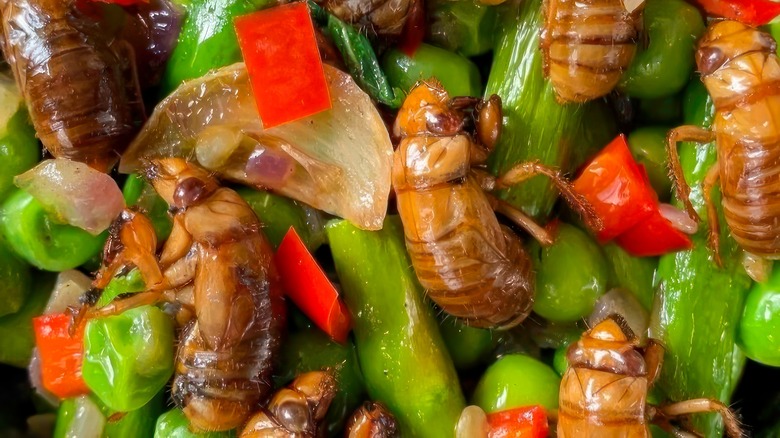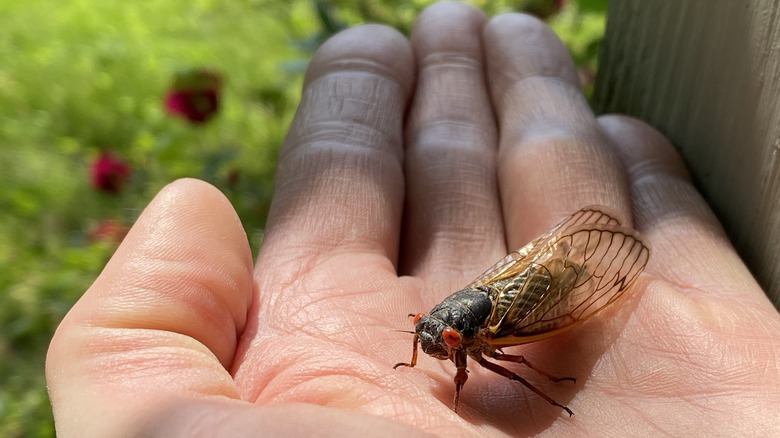How To Eat Cicadas Like A True Forager
Cicadas can be annual or periodical, and both varieties are safe to eat. While the former, as the name suggests, can be found every year in the summer, periodical cicadas have life cycles that keep them underground for 13 or 17 years (depending on the variety). Once every 200-odd years, the cycles overlap, resulting in a vast deluge of cicadas in various parts of the country. 2024 is one such year, and it may be the best time for a crash course in foraging for cicadas and taste-testing these low-fat, high-protein bugs.
For the squeamish, an interesting fact about eating cicadas is that they tend to have a milder taste than similar edible bugs like grasshoppers and crickets. This is because cicadas consume liquid tree sap, so their bodies are not full of half-digested plant solids. Instead, their taste is often described as nutty and their texture compared to soft-shell crab. Per the USDA, cicadas also contain some of the same proteins responsible for triggering shellfish allergies, so those with allergies should avoid eating them.
If you're up for trying some cicadas, a world of culinary possibilities awaits, to say nothing of the joys of foraging for your own food. Cicadas are easy to catch, versatile enough to use in sweet and savory dishes, and are a regular part of the diet in several countries. Here's how to get cicadas from the forest to your plate.
Foraging for cicadas
One of the best ways to forage for cicadas is by following their loud and distinctive mating calls. While annual cicadas can be found in most wooded areas around the country, their periodical counterparts tend to concentrate in the Midwest and Southeast. They emerge from the ground in warm weather, so depending on which part of the country you're in, expect them anywhere between May and August.
While any live cicada is fit to eat (avoid dead ones!), younger ones, called tenerals, are softer and better suited to a tasty meal. Once they mature, cicadas develop a hard exoskeleton which has to be peeled off before eating. Tenerals emerge around sunrise and sunset and can be found near the bases of trees. As their exoskeletons harden, they also turn darker in color, so you can identify tenerals by looking for cicadas with light green and pink hues. Once captured, tenerals should be frozen or cooked immediately to avoid their exoskeletons from hardening.
Cicadas don't sting or bite and are therefore safe to handle. However, make sure that the bug you're picking up is actually a cicada. You can identify them by their large transparent wings with clear vein patterns, two front legs, and four hind legs. When picking cicadas, ensure you do so in an area free of pesticides and other potential contaminants. Don't go cicada picking in areas near industrial farms or places that may have human or animal waste on the ground.
Cicadas taste better than other bugs, especially when cooked
Edible bugs often get categorized as merely an efficient and abundant source of protein, and while that is true, cicadas bring a lot more to the table (literally). In addition to their lighter, more palatable flavor, they also contain a more complex combination of carbohydrates and fats than the likes of grasshoppers and crickets, making cicadas a more nuanced ingredient. While deep frying or covering them in chocolate is the "novelty" way of preparing cicadas, they can also be roasted, sauteed, and even pickled. Because of their flavor, which some have likened to crab, cooking them in some olive oil with garlic leads to tasty results. You can also skewer and grill them like lobster tails.
However, cleaning is a crucial step before you get to the cooking. Like any other ingredient, cicadas must be thoroughly washed. You can freeze live cicadas overnight in an airtight bag or par-cook them in boiling water to euthanize and disinfect them. Next, wash them thoroughly under running water and trim their wings and exoskeleton off to be left with a cicada that's ready to be cooked.
@preciousaangel "I picked them at 6am today, im gonna fry them" :O screaming internally 😨
Cicadas can be cooked whole and used as the protein in most dishes, especially in your favorite shellfish recipes. If you are daunted by their appearance, chopping or grinding them can help with presentation, just like Acheta powder does for crickets. You can also replace crispy bacon bits with crunchy fried cicada bits for a new seasonal topping.


